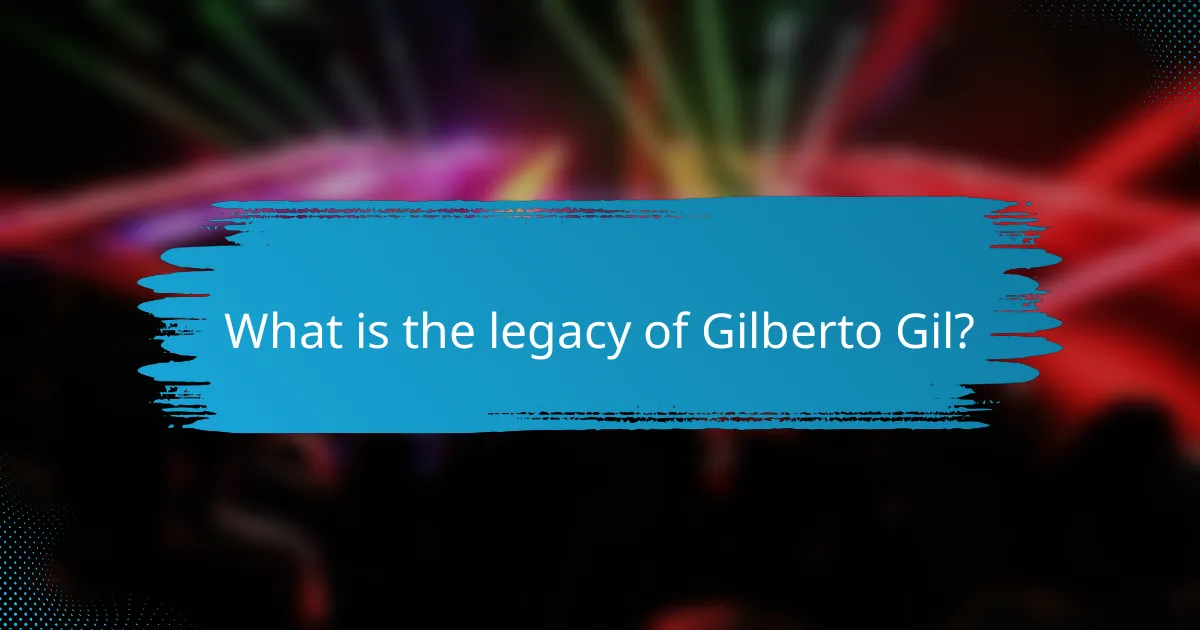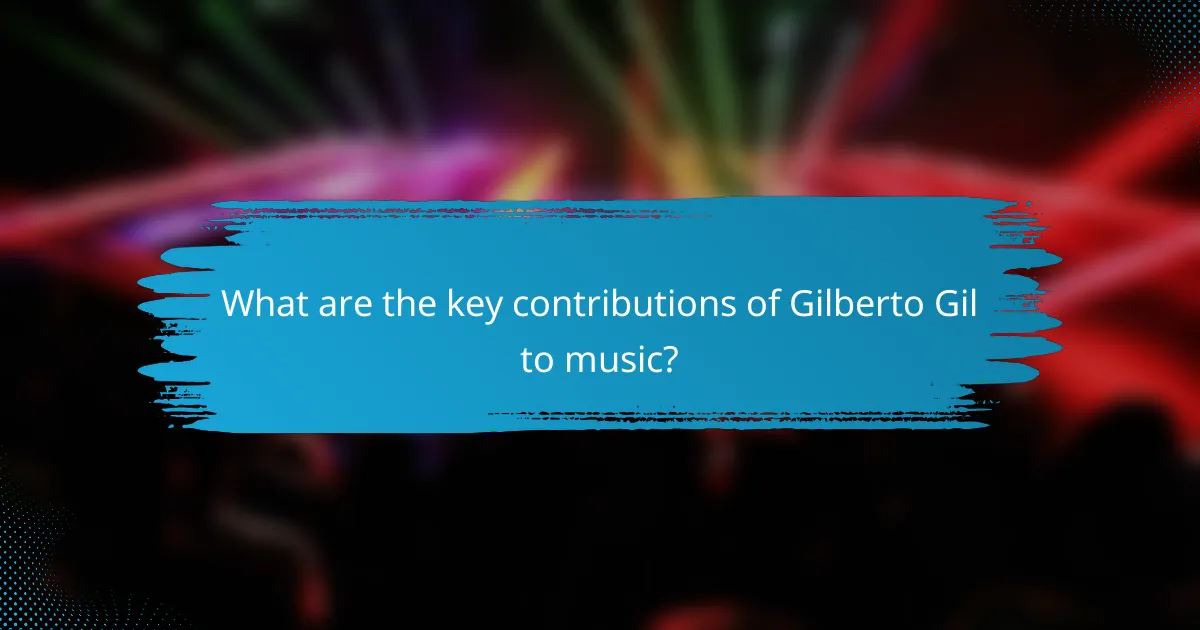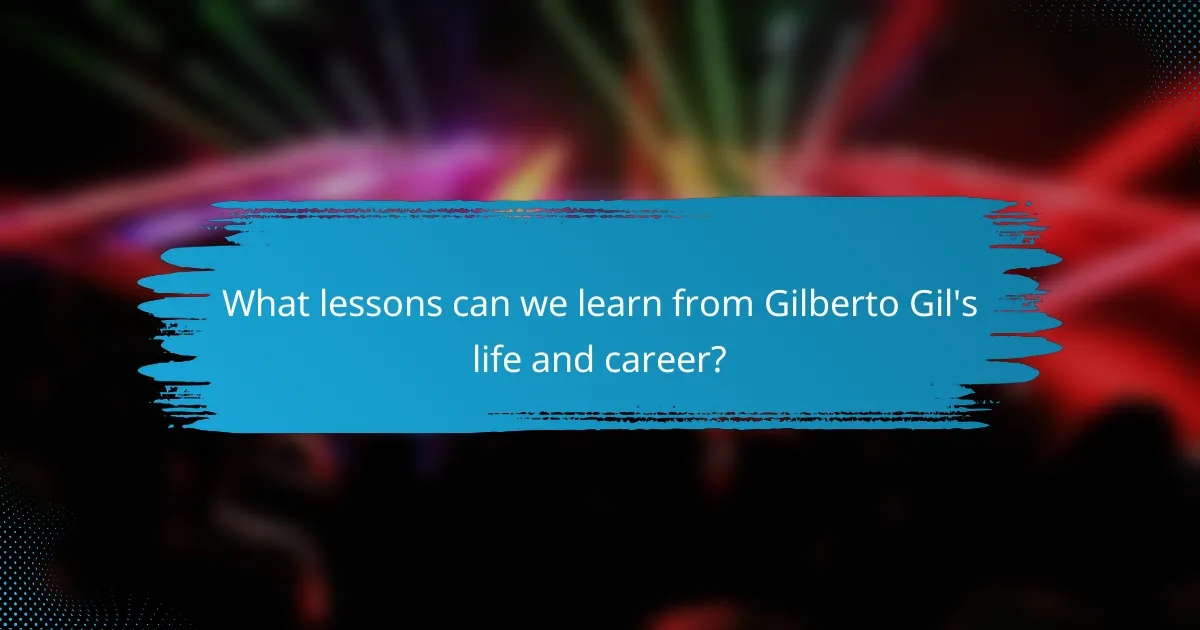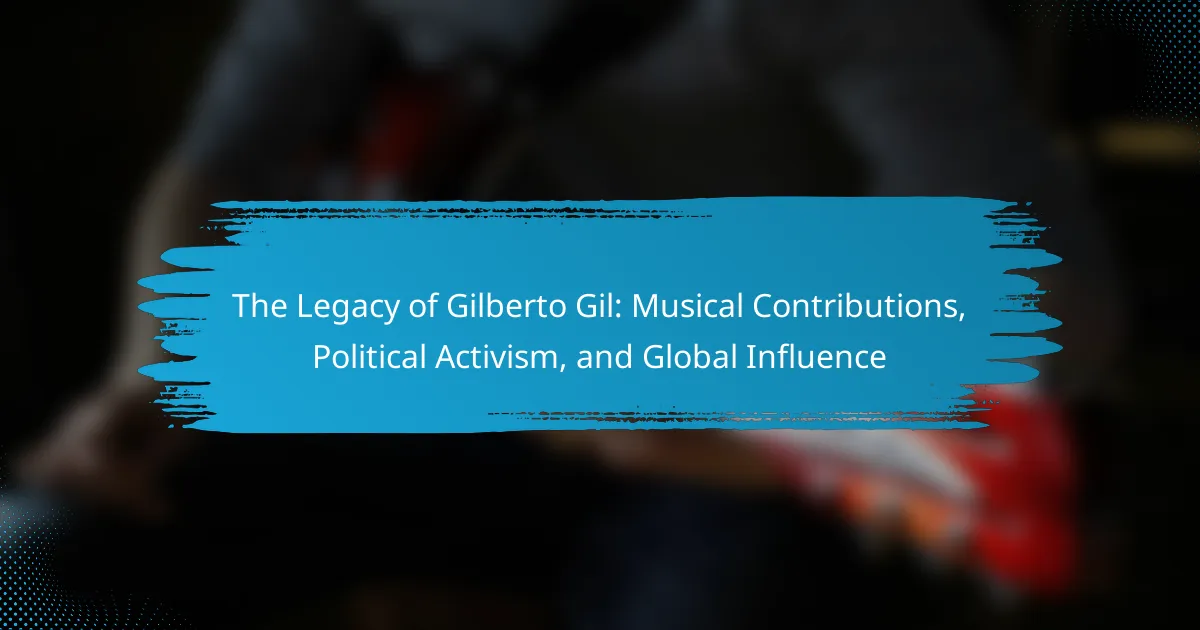Gilberto Gil is a prominent Brazilian musician and cultural figure known for his significant contributions to music and political activism. He played a crucial role in the Tropicália movement, which integrated traditional Brazilian music with diverse international influences, including samba, reggae, and rock. As Brazil’s Minister of Culture from 2003 to 2008, Gil advocated for cultural diversity and digital inclusion, reinforcing the importance of artistic expression. His collaborations with international artists and numerous Grammy Awards highlight his global influence and enduring legacy. Gil’s work continues to inspire new generations of musicians and activists, emphasizing the power of cultural fusion and social change.

What is the legacy of Gilberto Gil?
Gilberto Gil’s legacy is defined by his profound impact on Brazilian music and culture. He is a key figure in the Tropicália movement, which blended traditional Brazilian sounds with international influences. His music incorporates genres such as samba, reggae, and rock, showcasing his versatility. Gil’s political activism is notable; he served as Brazil’s Minister of Culture from 2003 to 2008. During his tenure, he promoted cultural diversity and digital inclusion. His global influence extends beyond music; he has collaborated with international artists, expanding Brazil’s cultural footprint. Gil’s work has earned him multiple Grammy Awards, affirming his significance in the music industry. His legacy continues to inspire new generations of musicians and activists worldwide.
How did Gilberto Gil’s music influence Brazilian culture?
Gilberto Gil’s music significantly influenced Brazilian culture by blending traditional Brazilian sounds with global music styles. His work popularized genres such as Tropicália, which merged samba with rock and other international influences. This fusion challenged cultural norms and encouraged artistic experimentation. Gil’s lyrics often addressed social and political issues, resonating with the Brazilian populace during times of political turmoil. His music became a voice for marginalized communities and inspired a generation of artists. Additionally, his role as a cultural ambassador helped to elevate Brazilian music on the world stage. Gil’s contributions have left a lasting impact on Brazil’s cultural identity and artistic landscape.
What genres did Gilberto Gil incorporate into his music?
Gilberto Gil incorporated various genres into his music, including samba, bossa nova, rock, reggae, and MPB (Música Popular Brasileira). His work reflects a blend of traditional Brazilian rhythms and contemporary styles. Gil’s innovative approach helped popularize these genres both in Brazil and internationally. He often fused elements from different musical traditions, creating a unique sound. This versatility contributed to his recognition as a key figure in the Tropicália movement. His collaborations with international artists further expanded his musical horizons. Gil’s genre-blending has influenced countless musicians worldwide.
How did his musical style evolve over the years?
Gilberto Gil’s musical style evolved significantly over the years. Initially, he was influenced by traditional Brazilian music forms like samba and bossa nova. In the late 1960s, he embraced tropicalia, blending rock, psychedelia, and Brazilian folk. This shift marked a departure from conventional styles, creating a fusion that resonated globally.
Throughout the 1970s, Gil incorporated reggae and African rhythms into his work. His experimentation with various genres continued into the 1980s and 1990s, where he explored pop and world music influences. In the 2000s, Gil’s style became more reflective, often integrating themes of social justice and cultural identity. His collaborations with international artists further showcased this evolution.
Gil’s ability to adapt while maintaining his Brazilian roots has solidified his legacy. His musical journey reflects broader cultural changes in Brazil and the world.
What role did Gilberto Gil play in political activism?
Gilberto Gil played a significant role in political activism in Brazil. He was a prominent advocate for cultural and social issues. His activism was closely linked to his music, which often addressed political themes. Gil was involved in the Tropicália movement, promoting artistic freedom and social change during Brazil’s military dictatorship. He served as Brazil’s Minister of Culture from 2003 to 2008. In this role, he focused on promoting Brazilian culture and supporting artists. Gil’s efforts included advocating for digital rights and cultural diversity. His work has influenced generations of artists and activists in Brazil and beyond.
How did his activism intersect with his musical career?
Gilberto Gil’s activism significantly influenced his musical career. He used his music as a platform for social and political change. His songs often addressed issues like poverty, inequality, and cultural identity in Brazil. Gil’s involvement in the Tropicalia movement merged art with political expression. He faced political repression during Brazil’s military dictatorship. This led him to use music as a form of resistance and protest. His exile in London further shaped his artistic vision, blending Brazilian sounds with global influences. Gil’s work continues to inspire activism through music today.
What specific political movements did he support?
Gilberto Gil supported various political movements, primarily focused on cultural rights and social justice. He was an advocate for the Afro-Brazilian movement, promoting the rights and visibility of Black Brazilians. Gil also supported environmental movements, emphasizing sustainable practices in Brazil. His political activism included involvement in the Workers’ Party, which aimed for social equality and labor rights. Additionally, he was a proponent of democracy and freedom of expression, particularly during Brazil’s military dictatorship. His contributions to these movements are documented in his music and public speeches, reflecting his commitment to social change.
How has Gilberto Gil’s global influence manifested?
Gilberto Gil’s global influence has manifested through his innovative music, cultural diplomacy, and political activism. He popularized Brazilian music genres like samba and bossa nova worldwide. His collaboration with international artists expanded the reach of Brazilian music. Gil’s role as Brazil’s Minister of Culture showcased his commitment to cultural exchange. He promoted Brazilian culture on global platforms. His music often addresses social issues, resonating with diverse audiences. Gil’s influence is evident in the global popularity of tropicalia, blending traditional and modern sounds. His artistic vision has inspired musicians across various genres internationally.
What international collaborations has he engaged in?
Gilberto Gil has engaged in numerous international collaborations throughout his career. He has worked with artists such as Caetano Veloso, collaborating on several projects that blend Brazilian music with global influences. Gil partnered with American musician Jack Johnson, creating songs that emphasize environmental awareness. He has also collaborated with renowned musicians like Herbie Hancock and Jimmy Cliff, showcasing his versatility across genres. In addition, Gil participated in the “Africa Brasil” project, which united various artists to celebrate African culture and heritage. His collaborations often reflect a fusion of traditional Brazilian sounds with international music styles. These partnerships highlight Gil’s commitment to cultural exchange and global musical dialogue.
How has his music been received outside Brazil?
Gilberto Gil’s music has been well-received outside Brazil. His fusion of traditional Brazilian sounds with global music genres has garnered international acclaim. Notably, he has performed at major music festivals worldwide. Critics often praise his innovative approach and lyrical depth. His albums have reached diverse audiences, contributing to the global popularity of Brazilian music. Gil’s influence extends to various artists across different genres. His collaborations with international musicians further enhance his global appeal. Overall, Gil’s music is celebrated for its cultural richness and artistic creativity on the world stage.

What are the key contributions of Gilberto Gil to music?
Gilberto Gil significantly contributed to music through his innovative blend of genres. He is a key figure in the Tropicália movement, which fused Brazilian music with international styles. His work incorporates elements of samba, bossa nova, rock, and reggae. Gil’s lyrics often address social and political themes, reflecting Brazil’s cultural landscape. He has released over 30 albums, showcasing his versatility as a songwriter and performer. His influence extends beyond Brazil, impacting global music and inspiring artists worldwide. Gil’s collaborations with international musicians further highlight his global reach and musical significance.
What are the most significant albums released by Gilberto Gil?
Gilberto Gil’s most significant albums include “Expresso 2222,” released in 1972. This album showcases his unique blend of tropicalia and Brazilian rhythms. Another notable album is “Refavela,” released in 1977, which highlights Afro-Brazilian influences. “Luzia Híbrida,” released in 1992, reflects his innovative approach to music and social commentary. “O Sol de Oslo,” released in 1998, emphasizes his global musical influences. These albums have received critical acclaim and contributed to his legacy as a pioneering artist in Brazilian music.
What themes are prevalent in his lyrics?
Gilberto Gil’s lyrics frequently explore themes of social justice, cultural identity, and personal freedom. His songs often reflect the struggles and aspirations of marginalized communities in Brazil. Gil addresses political issues and advocates for change through his music. He incorporates elements of Afro-Brazilian culture, celebrating heritage and diversity. Love and relationships are also prevalent in his work, showcasing emotional depth. Additionally, he touches on [censured] and the connection to nature. These themes resonate with listeners and contribute to his legacy as a transformative artist.
How did his work reflect social issues in Brazil?
Gilberto Gil’s work reflects social issues in Brazil through his music and activism. He addresses themes such as poverty, racial inequality, and political oppression. His songs often highlight the struggles of marginalized communities. For example, “Aquele Abraço” celebrates the culture of Rio de Janeiro while acknowledging its social challenges. Additionally, Gil’s involvement in politics as a Minister of Culture emphasizes his commitment to social change. He advocated for cultural diversity and social inclusion in Brazilian society. His artistic expressions serve as a voice for the disenfranchised, making social issues prominent in his work.
What innovations did Gilberto Gil bring to Brazilian music?
Gilberto Gil introduced several key innovations to Brazilian music. He blended traditional Brazilian styles with international genres such as rock and reggae. This fusion created a unique sound that appealed to a broader audience. Gil’s use of electric instruments transformed the acoustic nature of Brazilian music. He also incorporated social and political themes into his lyrics, reflecting contemporary issues. His involvement in the Tropicália movement further pushed artistic boundaries. This movement challenged cultural norms and embraced diverse influences. Gil’s innovations have left a lasting impact on Brazilian music and culture.
How did he blend traditional and modern musical elements?
Gilberto Gil blended traditional and modern musical elements by incorporating Brazilian folk styles with contemporary genres. He utilized instruments like the berimbau and guitar, which are rooted in Brazilian culture. Simultaneously, he integrated elements of rock, reggae, and funk into his music. This fusion created a unique sound that appealed to diverse audiences. His collaboration with other artists further enhanced this blend. Gil’s innovative approach helped redefine Brazilian music in the global context. His work exemplifies the seamless integration of cultural heritage with modern influences. This adaptability has solidified his status as a key figure in world music.
What impact did he have on future generations of musicians?
Gilberto Gil significantly influenced future generations of musicians through his innovative blending of genres. His fusion of Brazilian music with rock, reggae, and jazz expanded the possibilities of musical expression. Gil’s commitment to cultural identity inspired artists to explore their roots and incorporate diverse influences. He championed social and political themes, encouraging musicians to address contemporary issues in their work. His global collaborations showcased the potential for cross-cultural musical exchange. Additionally, Gil’s role in the Tropicália movement challenged artistic norms, promoting creativity and experimentation. His legacy continues to resonate, motivating new artists to push boundaries and embrace diversity in their music.

What lessons can we learn from Gilberto Gil’s life and career?
Gilberto Gil’s life and career teach us the importance of cultural fusion and social activism. His music blends various genres, showcasing the power of diversity in art. Gil’s involvement in politics emphasizes the role of artists in advocating for social change. He served as Brazil’s Minister of Culture, promoting cultural policies that support artistic expression. His resilience in facing political challenges highlights the significance of perseverance. Gil’s global influence demonstrates the ability of music to transcend borders and connect people. His commitment to environmental issues serves as a reminder of the artist’s responsibility towards society. Overall, Gil’s journey illustrates that creativity and activism can drive meaningful change.
How can aspiring musicians draw inspiration from Gilberto Gil?
Aspiring musicians can draw inspiration from Gilberto Gil by embracing his innovative fusion of genres. He blends traditional Brazilian music with rock, reggae, and jazz. This approach encourages artists to experiment with diverse musical styles. Gil’s lyrics often reflect social issues and personal experiences. This thematic depth can inspire musicians to write meaningful, relatable songs. His commitment to political activism demonstrates the power of music as a tool for change. Aspiring artists can learn to use their platform for social justice. Additionally, Gil’s global influence shows the importance of cultural exchange. Musicians can explore international collaborations to broaden their musical horizons.
What practices did he adopt to maintain his relevance in music?
Gilberto Gil adopted several practices to maintain his relevance in music. He embraced musical experimentation, blending traditional Brazilian sounds with global genres. Gil utilized technology and social media to reach new audiences. He engaged in collaborations with diverse artists across various music styles. Regularly performing at festivals and events kept him in the public eye. Gil also addressed contemporary social issues through his lyrics, resonating with younger generations. His active participation in cultural and political discussions further solidified his influence. These practices collectively ensured his enduring presence in the music industry.
How can political activism enhance an artist’s impact?
Political activism can enhance an artist’s impact by amplifying their voice and message. Engaging in social issues allows artists to connect deeply with their audience. This connection often fosters a sense of community and shared purpose. For example, Gilberto Gil used his music to address political and social issues in Brazil. His activism helped raise awareness about cultural identity and social justice. As a result, his influence extended beyond music into societal change. Studies show that artists involved in activism can inspire action and mobilize support for causes. This dual role as an artist and activist creates a lasting legacy that resonates with future generations.
What are some best practices for engaging in cultural activism through music?
Engaging in cultural activism through music involves several best practices. First, artists should create music that reflects social issues. This approach raises awareness and encourages dialogue. Second, collaboration with other activists enhances the message’s reach. Working with diverse voices strengthens the impact. Third, utilizing social media platforms is essential for broader dissemination. These platforms allow for real-time engagement with audiences. Fourth, organizing community events fosters local involvement. Live performances can galvanize support for specific causes. Fifth, educating listeners about the issues addressed in the music is crucial. This can include providing context through lyrics or accompanying materials. Lastly, maintaining authenticity in the message resonates more deeply with audiences. Authenticity builds trust and encourages loyalty among supporters. These practices have been effectively utilized by numerous artists, including Gilberto Gil, who blended music with activism to promote cultural and social change.
Gilberto Gil is a pivotal figure in Brazilian music and culture, known for his contributions to the Tropicália movement, which fused traditional Brazilian sounds with global influences. His music spans genres such as samba, reggae, and rock, and addresses social and political themes, reflecting the cultural landscape of Brazil. Gil’s role as Minister of Culture and his political activism further underscore his commitment to cultural diversity and social justice. His global collaborations and innovative approach have significantly impacted both Brazilian music and international audiences, inspiring future generations of musicians and activists.
